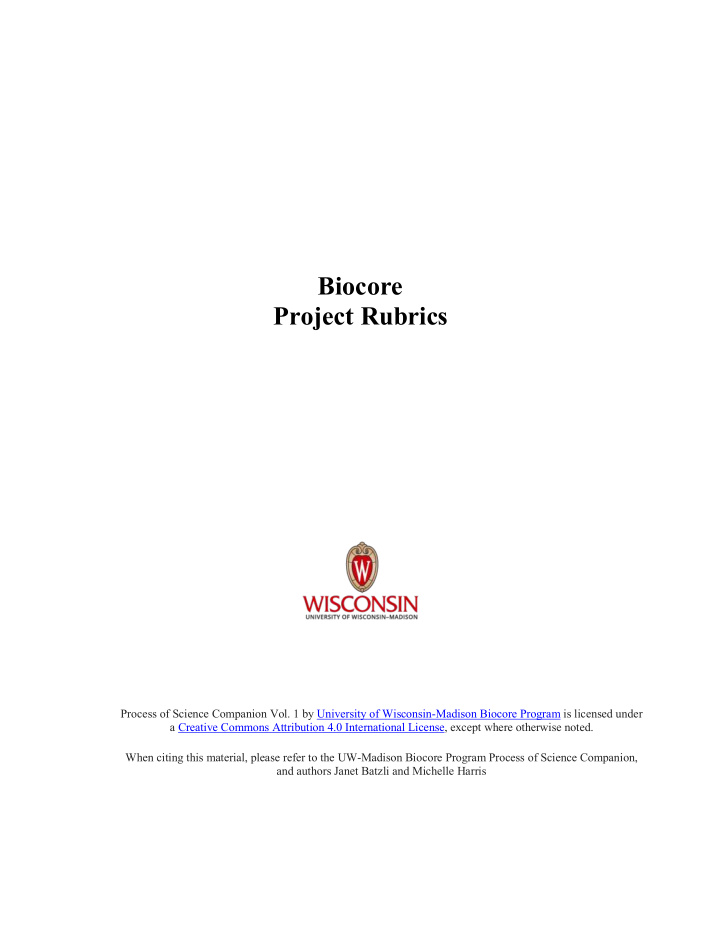



Biocore Project Rubrics Process of Science Companion Vol. 1 by University of Wisconsin-Madison Biocore Program is licensed under a Creative Commons Attribution 4.0 International License, except where otherwise noted. When citing this material, please refer to the UW-Madison Biocore Program Process of Science Companion, and authors Janet Batzli and Michelle Harris
Biocore FINAL PAPER Review Rubric 0 = inadequate 1 =adequate 2 = good 3 = very good 4 = excellent Title Point of experiment Has two or more problems Title could be more concise but still Title is concise & conveys main point of Title is concise, conveys main point cannot be determined comparable to the following: Title is conveys main point of experiment; 2 or experiment but 1 key component is missing of experiment, and includes these by title not concise, point of experiment is more key components are missing key components: study system, difficult to determine by title, most variables, result, & direction. [With key information is missing systematic observations, results may be too preliminary to define direction so title should be more general.] Abstract Abstract is missing or, Many key components are missing; Covers all but 2 key components and/or Concisely & clearly covers all but one key Concisely & clearly covers all key if present, provides no those stated are unclear and/or are could be done more clearly and/or component OR clearly covers all key components in 200 words or less: relevant information. not stated concisely. concisely. components but could be more concise and/or biological rationale, hypothesis, clear. approach, result direction & conclusions Introduction 4-5 key components are Covers all but 3 key components & Covers all but 2 key components OR Concisely & clearly covers all but one key Clearly, concisely, & logically very weak or missing; could be more concise and/or clear. clearly covers all but 1 key component component (w/ exception of rationale) OR presents all key components: BIG PICTURE: those stated are unclear OR clearly covers all but 2 key but could be done much more logically, clearly covers all key components but could be relevant & correctly cited Did Intro convey and/or not stated components but could be done much clearly, and/or concisely. more concise and/or clear. background information, question, why experiment concisely. more logically, clearly, and/or e.g., biological rationale not fully e.g., has done a reasonably nice job with the biological rationale (including was performed and Weak/missing concisely. developed but still supports hypothesis. Intro but fails to state the approach OR has biological assumptions about how what is was components make it e.g., background information is not Remaining components are done done a nice job with Intro but has also included the system works and knowledge designed to test? difficult to follow the focused on a specific question and reasonably well, though there is still some irrelevant background information gap), hypothesis, approach. (There rest of the paper. Often minimal biological rationale is room for improvement. may be a few minor issues with results in hypothesis presented such that hypothesis isn’t Includes information that is extraneous organization/clarity.) that “comes out of entirely logical and detracting from the main ideas. nowhere.” Methods & So little information is Procedure is presented such that a Procedure is presented such that a Concisely, clearly, & chronologically describes Concisely, clearly, & chronologically presented that reader reader could replicate experiment reader could replicate experiment only procedure used so that reader could replicate describes procedure used so that Materials could not possibly but methods are largely after learning a few more key details most of experiment with the exception of a few knowledgeable reader could replicate BIG PICTURE: replicate experiment inappropriate to test hypothesis OR OR methods used are reasonably relatively minor details. Methods used are experiment and understand the Did Methods OR methods are Procedure is presented such that a appropriate for study, though a more appropriate for study. Minor problems with results. Methods used are entirely inappropriate to reader could replicate experiment straight-forward approach may have organization OR some irrelevant/ superfluous appropriate for study. Clearly defines clearly describe test hypothesis only after learning several more key been taken. information. controls and how they will inform how hypothesis details . the experiment. was tested? Briefly describes mathematical manipulations or statistical analyses. Results Major problems that Has 3-5 problems comparable to the Has presented findings with a Has presented both a concise, narrative text & With a few minor exceptions, leave reader following: narrative text and & reasonably good narrative text & informative tables/figures without biological contains a concise, well-organized BIG PICTURE: uninformed; narrative tables/figures are minimal and informative tables/figures, but has 2-3 interpretation, but has made 1-2 minor narrative text & tables/figures that Did the Results text is lacking entirely, mostly uninformative, some relevant problems comparable to the following: omissions or has other relatively small highlight key trends/ patterns/output clearly & tables & figures contain data are present but are mixed in most relevant data are present but are problems. e.g., relevant data & trends are from statistical tests without effectively display unclear and/or with much unnecessary information, mixed in with some unnecessary summarized well and without biological biological interpretation. Tables & relevant data? irrelevant information. trends are not immediately apparent information, trends are shown in figures interpretation, but tables & figures have very figures have appropriate legends/ e.g., “Results” contain in figures and are not explicitly noted but are not explicitly noted, tables & brief legends that leave out some key details. labels & can stand on their own. no text, raw data are in in text, tables & figures lack legends, figures have very brief legends that a table w/ poor legend. variation around mean values is not leave out key details, variation around If you have problems collecting valid indicated in either text or figures, mean values is not indicated in figures, data, state what the problem was that conclusions about hypothesis are conclusions about hypothesis are briefly makes your data invalid. emphasized. made.
Recommend
More recommend